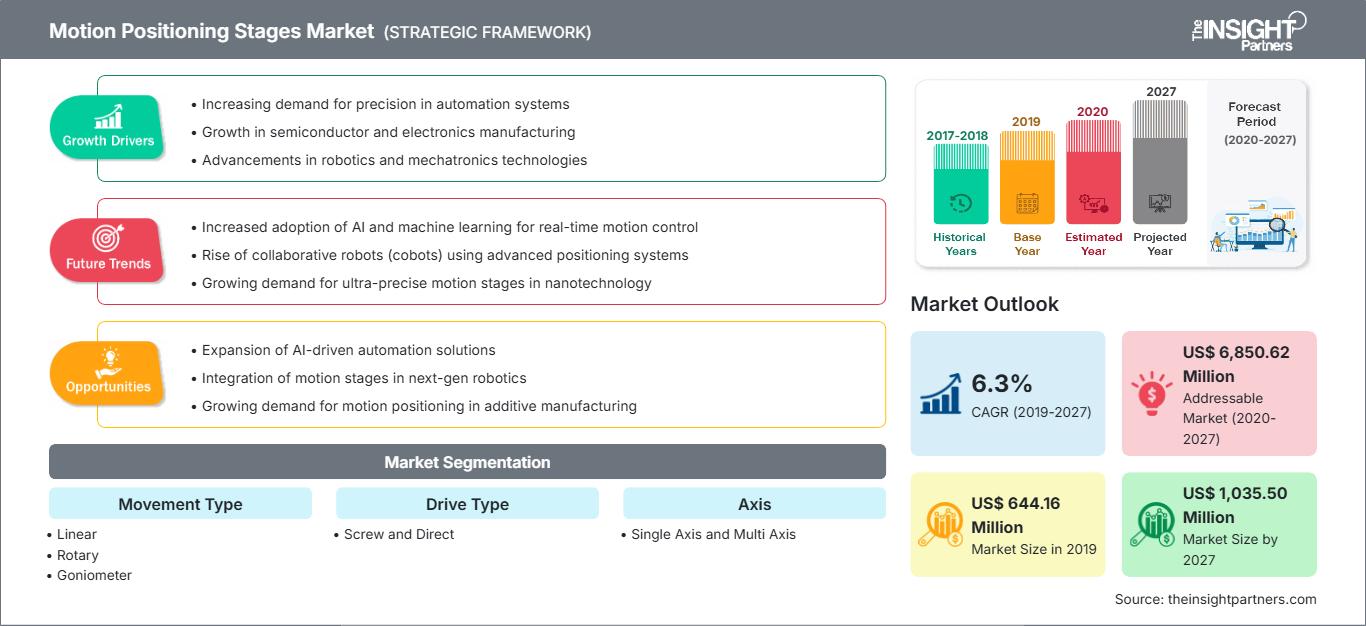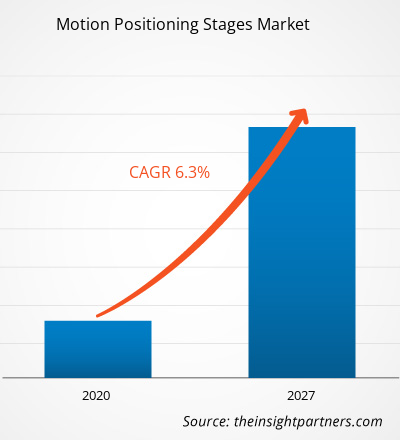Der Markt für Bewegungspositioniertische wurde 2019 auf 644,16 Millionen US-Dollar geschätzt und soll bis 2027 1.035,50 Millionen US-Dollar erreichen; von 2020 bis 2027 wird ein CAGR-Wachstum von 6,3 % erwartet.
Zu den Positionierungs- und Bewegungsaufgaben gehören Montage, Halbleiterfertigung, Inspektionssysteme, Lasermaterialbearbeitung oder additive Fertigung. Diese Aufgaben gehören zu den Aufgaben der industriellen Automatisierung, die robuste und zuverlässige Lösungen erfordern. Genauigkeit, hohe Dynamik und exakte Positionsreproduzierbarkeit sind wesentliche Anforderungen der industriellen Automatisierung. Im Zeitalter kontinuierlicher technologischer Entwicklungen gewinnt Industrie 4.0 zunehmend an Bedeutung und treibt den Trend der industriellen Automatisierung branchenübergreifend voran. Die genannten Anforderungen können erfüllt werden, wenn Antriebstechnik, Mechanik und Steuerelektronik eines Positionierungssystems perfekt aufeinander abgestimmt sind. Dieser Aspekt wird den Bedarf an Bewegungspositioniertischen in verschiedenen Branchen in den kommenden Jahren weiter ankurbeln. Neben dem Wachstum der Bewegungspositionierung wächst auch der zunehmende Einsatz von Automatisierung in verschiedenen Fertigungsindustrien wie der Lebensmittel- und Getränkeindustrie, der Halbleiterindustrie, der Elektronikindustrie und der Automobilindustrie exponentiell. Die steigende Nachfrage nach Präzisionsfertigung in Branchen weltweit ist ein weiterer Faktor, der die Bewegungspositionierung fördert. Alle oben genannten Aspekte treiben das Marktwachstum an. Darüber hinaus wirken sich die Ausweitung des Miniaturisierungskonzepts im Gesundheitswesen und der Unterhaltungselektronikindustrie sowie die zunehmende Nutzung von Industrie 4.0 positiv auf die industrielle Automatisierung aus und beeinflussen somit das Marktwachstum. Der hohe Wartungsaufwand und die begrenzte Lebensdauer könnten jedoch das Marktwachstum für Bewegungspositionierungstische behindern.
Der Markt für Bewegungspositionierungstische ist grob in fünf Hauptregionen unterteilt: Nordamerika, Europa, APAC, MEA und SAM. Gemessen am Marktanteil dominierte APAC 2019 den globalen Markt für Bewegungspositioniertische, gefolgt von Europa und Nordamerika. In Nordamerika trägt die starke Präsenz von Unternehmen wie Aerotech Inc., Parker Hannifin und Newport Corporation, die für die Entwicklung von Bewegungspositioniertischen verantwortlich sind, dazu bei, dass diese schneller in die Endverbrauchsindustrien Einzug halten. Europa ist ein weiterer entscheidender Markt für das künftige Wachstum des Marktes für Bewegungspositioniertische im Prognosezeitraum. Finnland, Deutschland, Frankreich und Großbritannien sind einige der wichtigsten Länder mit hohem Wachstum in verschiedenen Fertigungsindustrien. Dieser Aspekt wird die Nachfrage nach Bewegungspositioniertischen in Europa ankurbeln. Darüber hinaus sind in der Region auch etablierte Unternehmen der Automobil- sowie der Gesundheits- und Pharmabranche vertreten, die wichtige Anwender industrieller Automatisierung sind. Dieser Aspekt wird zur Einführung von Bewegungspositioniertischen in Europa beitragen. In Bezug auf das Wachstum wird APAC voraussichtlich die am schnellsten wachsende Region sein, mit einer beeindruckenden CAGR von 7,6 % zwischen 2020 und 2027. Die Region Asien-Pazifik umfasst Entwicklungsländer wie China, Indien, Vietnam und andere südostasiatische Länder sowie Industrieländer wie Japan und Australien. Die Fertigungsindustrie in den asiatischen Ländern boomt exponentiell, was die Verbreitung von Industrie 4.0 vorantreiben wird. Durch die Nutzung der Industriellen Vierten Revolution zur Rationalisierung der Fertigungsprozesse wächst der Einsatz von Positioniersystemen in den asiatischen Volkswirtschaften rasant. Darüber hinaus ist die asiatische Wirtschaft für ihre starke Unterhaltungselektronik- und Halbleiterindustrie bekannt, was die zunehmende Verbreitung von Positioniersystemen weiter begünstigt. Auch in den Ländern des Nahen Ostens und Südasiens (MEA) und Süd-Amerikas (SAM) wird Industrie 4.0 und die industrielle Automatisierung eingeführt, was das zukünftige Wachstum dieses Marktes in den kommenden Jahren vorantreiben dürfte. Die COVID-19-Pandemie wirkt sich weltweit auf die Industrie aus, und die Weltwirtschaft wird voraussichtlich im Jahr 2020 und wahrscheinlich auch im Jahr 2021 am stärksten betroffen sein. Der Ausbruch hat zu erheblichen Störungen in verschiedenen Branchen geführt, darunter in der Elektronik- und Halbleiterindustrie, der Automobilindustrie, der Verteidigungsindustrie, der Medizintechnik und anderen Fertigungsunternehmen.
Passen Sie diesen Bericht Ihren Anforderungen an
Sie erhalten kostenlos Anpassungen an jedem Bericht, einschließlich Teilen dieses Berichts oder einer Analyse auf Länderebene, eines Excel-Datenpakets sowie tolle Angebote und Rabatte für Start-ups und Universitäten.
Markt für Bewegungspositionierungsstufen: Strategische Einblicke

-
Holen Sie sich die wichtigsten Markttrends aus diesem Bericht.Dieses KOSTENLOSE Beispiel umfasst Datenanalysen, die von Markttrends bis hin zu Schätzungen und Prognosen reichen.
Branchen wie die Medizintechnik, die Halbleiter- und Elektronikindustrie, die Automobilindustrie, die Luft- und Raumfahrt- und Verteidigungsindustrie sowie der Maschinenbau treiben Veränderungen in ihren industriellen Abläufen voran. Alle diese Branchen treiben den Wandel auf die eine oder andere Weise voran. Die Nachfrage nach Positioniertischen wird von Sektoren getrieben, in denen hoher Wert auf Genauigkeit und Präzision gelegt wird. Auch die steigende Anzahl und Komplexität von Anwendungen in der industriellen Automatisierung und von Positioniertischen treibt die Nachfrage nach Positioniertischen in Fabrikhallen an. Der Bedarf an mehrachsigen Bewegungssteuerungen in hochwertigen und schnellen Bewegungssteuerungsanwendungen in Branchen wie der Halbleiter-, Lebensmittel- und Getränkeindustrie, der Automobilindustrie, der Metall- und Maschinenbauindustrie sowie der Medizintechnik steigt stetig an. Die hohe Geschwindigkeit, Genauigkeit und konstante Leistung von Positioniertischen treiben die Nachfrage nach diesen Steuerungen branchenübergreifend an und treiben so das Marktwachstum weltweit voran.
Markteinblicke nach Bewegungsarten
Positioniertische werden in Bewegungssteuerungssystemen verwendet, die erweiterte Maschinenfunktionen bieten, um diese für bestimmte Vorgänge zu positionieren. Entwicklungen bei Bewegungspositionierungstischen verbessern deren mechanische Komponenten und ermöglichen präzise Bewegungen sowie die Synchronisierung komplexer Achsenbefehle. Sie bieten verschiedene Bewegungsarten, z. B. Linear-, Dreh- und Goniometerbewegungen. Lineare Typen bewegen sich geradlinig und sind üblicherweise übereinander angeordnet, um Bewegungen in verschiedene Richtungen zu ermöglichen. Drehbewegungen rotieren im Allgemeinen um den Mittelpunkt. Goniometer rotieren um einen Punkt im Raum; sie bewegen sich in einem Bogen statt auf einer geraden Linie. Sie werden in zahlreichen Anwendungen eingesetzt, z. B. in Laserschneidmaschinen, der Automatisierung und der industriellen Handhabung. Darüber hinaus werden technologische Fortschritte, wie das Aufkommen digitaler Bewegungspositionierungstische, die Nachfrage nach Bewegungspositionierungstischen in naher Zukunft voraussichtlich erhöhen.
Markteinblicke nach Antriebsarten
Auf Grundlage der Antriebsarten wird der Markt in Schrauben- und Direktantriebe segmentiert. Typischerweise werden in der magnetischen Direktantriebstechnologie zwei Arten bürstenloser Linearmotoren verbaut: Linearmotoren mit Eisenkern und Linearmotoren ohne Eisenkern. Eisenlose Motoren erfreuen sich im Bereich der präzisen Bewegungssteuerung einer vergleichsweise größeren Marktnachfrage, da sie einen gleichmäßigen Bewegungsablauf ermöglichen und daher für präzise Bewegungssteuerungsanwendungen bevorzugt werden. Zahlreiche Unternehmen sind stark in das Angebot von Direktantrieben involviert.
Produktentwicklung ist die gängige Strategie von Unternehmen, um ihr Produktportfolio zu erweitern. Parker Hannifin Corporation, MISUMI Corporation, Newport Corporation, Physik Instrumente (PI) GmbH & Co. KG. und Aerotech Inc. sind unter anderem die Hauptakteure, die Strategien zur Vergrößerung des Kundenstamms und zur Gewinnung bedeutender Anteile am globalen Markt für Bewegungspositioniertische umsetzen, was ihnen wiederum die Aufrechterhaltung ihres Markennamens ermöglicht. Einige der jüngsten wichtigen Entwicklungen sind:
- Im Jahr 2019 gründete die MISUMI Group Inc. das „Naka-Nihon Ryutsu Center“ (Logistikzentrum Zentraljapan) in der Region Chubu, um eine zuverlässige und schnelle Lieferung zu gewährleisten. Dieser dritte Logistikstandort in Japan unterstützt zusätzlich eine schnelle Lieferung in der Tokai-Region und den benachbarten Präfekturen.
- Im Jahr 2019 erwarb die Parker Hannifin Corporation die LORD Corporation, um eine integrierte Organisation mit starken Kompetenzen in den Bereichen Materialwissenschaft, Elektrifizierung und Luft- und Raumfahrt zu schaffen, die sich hervorragend ergänzen.
Markt für Bewegungspositionierungsstufen
Die Analysten von The Insight Partners haben die regionalen Trends und Faktoren, die den Markt für Bewegungspositionierungsbühnen im Prognosezeitraum beeinflussen, ausführlich erläutert. In diesem Abschnitt werden auch die Marktsegmente und die geografische Lage in Nordamerika, Europa, im asiatisch-pazifischen Raum, im Nahen Osten und Afrika sowie in Süd- und Mittelamerika erörtert.Umfang des Marktberichts zu Bewegungspositionierungsbühnen
| Berichtsattribut | Einzelheiten |
|---|---|
| Marktgröße in 2019 | US$ 644.16 Million |
| Marktgröße nach 2027 | US$ 1,035.50 Million |
| Globale CAGR (2019 - 2027) | 6.3% |
| Historische Daten | 2017-2018 |
| Prognosezeitraum | 2020-2027 |
| Abgedeckte Segmente |
By Bewegungstyp
|
| Abgedeckte Regionen und Länder |
Nordamerika
|
| Marktführer und wichtige Unternehmensprofile |
|
Dichte der Marktteilnehmer in Motion-Positioning-Phasen: Verständnis ihrer Auswirkungen auf die Geschäftsdynamik
Der Markt für Bewegungspositionierungstische wächst rasant. Dies wird durch die steigende Endverbrauchernachfrage aufgrund veränderter Verbraucherpräferenzen, technologischer Fortschritte und eines stärkeren Bewusstseins für die Produktvorteile vorangetrieben. Mit der steigenden Nachfrage erweitern Unternehmen ihr Angebot, entwickeln Innovationen, um den Bedürfnissen der Verbraucher gerecht zu werden, und nutzen neue Trends, was das Marktwachstum weiter ankurbelt.
- Holen Sie sich die Markt für Bewegungspositionierungsstufen Übersicht der wichtigsten Akteure
- Linear
- Rotativ
- Goniometer
Nach Antriebstyp
- Schraube
- Direkt
Nach Achse
- Einzelachse
- Mehrachsig
Nach Lagertyp
- Luftlager
- Gleitlager
Nach Belastung
- 0–20 kg
- 21–50 kg
- 51–100 kg
- 101–140 kg
- Über 140 kg
Nach Anwendung
- Biotechnologie
- Laser Schneiden
- Automatisierung
- Industrielle Handhabung
- Sonstige
Firmenprofile
- Aerotech Inc.
- Dover Motion
- Edmund Optics Inc.
- MISUMI Corporation
- Newport Corporation
- Optimal Engineering Systems, Inc.
- OWIS GmbH
- Parker Hannifin Corporation
- Physik Instrumente (PI) GmbH & Co. KG.
- STANDA LTD
- Historische Analyse (2 Jahre), Basisjahr, Prognose (7 Jahre) mit CAGR
- PEST- und SWOT-Analyse
- Marktgröße Wert/Volumen – Global, Regional, Land
- Branchen- und Wettbewerbslandschaft
- Excel-Datensatz
Aktuelle Berichte
Erfahrungsberichte
Grund zum Kauf
- Fundierte Entscheidungsfindung
- Marktdynamik verstehen
- Wettbewerbsanalyse
- Kundeneinblicke
- Marktprognosen
- Risikominimierung
- Strategische Planung
- Investitionsbegründung
- Identifizierung neuer Märkte
- Verbesserung von Marketingstrategien
- Steigerung der Betriebseffizienz
- Anpassung an regulatorische Trends






















 Kostenlose Probe anfordern für - Markt für Bewegungspositionierungsstufen
Kostenlose Probe anfordern für - Markt für Bewegungspositionierungsstufen